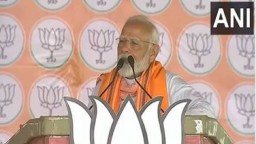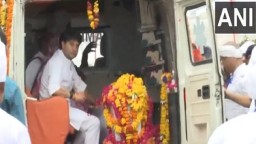Latest News
CAN BHARAT JODO YATRA BRING OPPN PARTIES TOGETHER?

The 150-day Bharat Jodo Yatra which began on September 7, 2022, will culminate in Srinagar on January 30, 2023… on the Martyr’s Day to mark the anniversary of the assassination of Mahatma Gandhi… by then, the Bharat Jodo Yatra, however, would have traversed the length of the country from the Kanyakumari to the Himalayas.
With a motive to fight against communalism, unemployment, hatred, inflation, and political centralisation, the Bharat Jodo Yatra has definitely pumped in the much-needed zeal into the Congress cadre. It has been seen in several visuals across the country how much response the yatra received especially from the youth.
Yatra to boost Cong?
However, the million-dollar question is that will this Himalayan task undertaken by the Gandhi scion be able to translate the same into electoral success for the Grand Old Party? A question, one and all have been asking. It may be remembered that during the Bharat Jodo Yatra, the high-octane Gujarat assembly election was held, but notwithstanding the political frenzy, the party campaigned in “its way” while Rahul remained with the yatra. However, the outcome is there for all to witness.
Even as Congressmen say in unison that Bharat Jodo Yatra’s purpose was not political, but then the glaring question would be what purpose the yatra would ultimately serve… in the bigger perspective for the party in the coming years, especially keeping the 2024 Lok Sabha elections in mind and not to forget that in two states where its party is ruling will be going to the polls in 2023.
Whether the combined Opposition Front or strength or call it what you want… likes it or not, even today after this fall and the current electoral status, the Congress is still the largest Opposition party across the length and breadth of the country as far as statistics is concerned.
It may be recalled that the Congress, in the 2019 Lok Sabha, won a mere 52 seats, but the party stood second in a whopping 196 seats and bagged around 19.5 per cent of the total votes polled.
Cong still a factor
It is still a fact that despite the advent of several regional parties, the Grand Old Party still stands as the main Opposition in 12 states in the country currently and they are…. Nagaland, Mizoram, Meghalaya, Manipur, Goa, Jharkhand, Maharashtra, Haryana, Kerala, Assam, Karnataka and Punjab. Which is no mean feat.
Apart from this, the Congress is in direct headon political contest with the Saffron Might in states like Chhattisgarh, Gujarat, Himachal Pradesh, Madhya Pradesh, Uttarakhand, Rajasthan and Arunachal Pradesh.
All said and done, despite the din…hustle and bustle of the Opposition parties and their sudden emergence in a state or two, no other party has such a presence despite the relentless erosion of their votebank.
Hence all these efforts by the Bihar chief minister or at times KCR and even Mamata Banerjee’s meeting with Sharad Pawar will be difficult to translate into any kind of electoral challenge without the presence of the Congress in the third front at least for now. For a collective fight from the Opposition camp (if that is at all going to happen) the Congress presence is required given the “ground reality.”
What’s the reality?
So long we have spoken about the Congress’ huge footprint across the country as a major Opposition political force, now let’s analyse the party frame by frame on its weaknesses and find out through our arguments whether the Congress has that bargaining capability given the current scenario keeping the electoral decay in mind.
The Grand Old Party has seen a steady decline in its electoral fortunes since the Nineties. We need to assess how the party gradually lost its grip over the grassroots organisations. The party had become completely centralised and all decisions were coming ONLY from the top.
In a bid to make the party more and more centralised, the orgnaisation thereby weakened and this led to factionalism and heartburn and mass desertions. Even as Mallikarjun Kharge was chosen as the party president, the high command status and the Gandhi family’s “presence” is undenying as far as top decisions are concerned.
One more important issue the Grand Old Party has to take into account is that elections to the Congress Working Committee have not been held since 1988. And what has worked even worse for the party was Congress committees and party offices started having people through selection instead of election. Complete centralisation of the Grand Old Party finally pulled the plug on the grassroots organisations, which actually translate the support of people into votes.
Unhappiness among the ranks has led to widespread factions and that ate up the unity of the party from the base and the party’s fortunes collapsed like nine pins. Even in the states where the party is in power, it is not unknown to one and all about intraparty factionalism and reported dissatisfaction. The G-23 group of senior leaders, who demanded organisational reform and an inclusive and collective decision-making system… have to an extent further divided the party.
Though the Yatra is not aimed at political reformation, it is a welcome move to see that the Congress has invited 21 “like-minded” political parties to join the concluding event of the yatra in Srinagar. The Trinamool Congress, Janata Dal, United, Telugu Desam Party, CPI(M), Rashtriya Janata Dal, the Samajwadi Party and BSP are among those who have been invited. And mind you, even here the AAP has not been invited. However, even this move does not seem to be doing enough to amalgamate the Opposition force in the right earnest.
Meanwhile, as I discussed above, with some degree of success, each Opposition party has created a buffer zone around itself, thinking and dreaming of taking up the mantle of leading the Opposition front. It is to be seen how the Bharat Rashtra Samiti rally organised by Telangana Chief Minister KCR in Khammam on January 18 really shapes up at forming a non-BJP, non-Congress, national alternative. The BRS rally is likely to be attended by leaders like Mamata Banerjee and Arvind Kejriwal.
THE VIEWS EXPRESSED BY THE AUTHOR ARE PERSONAL
ROBIN ROY The writer is Senior Journalist and former Managing Editor, First India








.png)






.png)




.png)
